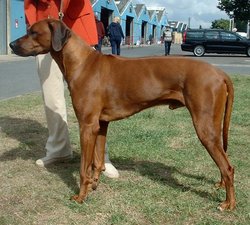Rhodesian Ridgeback
|
|
| Rhodesian Ridgeback | |||||||||||||||||
|---|---|---|---|---|---|---|---|---|---|---|---|---|---|---|---|---|---|
 The Rhodesian Ridgeback is the only breed besides the Thai Ridgeback with a ridge of fur along the spine. | |||||||||||||||||
| Country of origin | |||||||||||||||||
| South Africa | |||||||||||||||||
| Classification and breed standards | |||||||||||||||||
|
The Rhodesian ridgeback is a breed of dog from South Africa. Known as the "Lion dog" because of their unique ability to taunt a lion and keep them at bay while awaiting their master to make the kill. They rarely bark while hunting.
| Contents |
Appearance
The Ridgeback's general appearance is of a handsome, strong, muscular and active dog, symmetrical in outline, capable of great endurance with a fair amount of speed. The mature dog is handsome and upstanding. The Ridgeback's distinguishing feature is the ridge of hair along its back running in the opposite direction to the rest of its coat. The ridge must be regarded as the escutcheon of the breed. It consists of a fan-like area formed by two whorls of hair (called "crowns") and tapers from immediately behind the shoulders, down to the level of the hips. The ridge is usually about 2 inches (5 cm) in width at its widest point. The ridge is believed to originate from the dog used by the original African population, who carried a similar ridge. The first picture of a Ridgeback is a wall painting describing the life of the Boers. The painting is situated in South Africa in the voortrekker monument.
Male Ridgebacks should be 25-27 inches (64-69 cm) at the withers and weigh approximately 85 lb (36.5 kg FCI Standard), females 24-26 inches (61-66 cm) and approximately 70 lb (32 kg). They are typically muscular and have a light wheaten to red wheaten coat which should be short and dense, sleek and glossy in appearance but neither woolly nor silky. The coat should contain no black hairs, although white is acceptable on the chest and toes. Ridgebacks have a strong, smooth tail, which is usually carried in a gentle curve upwards. The eyes should be round and should reflect the coat colour—dark in a black muzzle, amber with a brown nose. The brown nose is a recessive gene and is therefore not as common as a black nose.
Temperament
They are loyal, intelligent, and gentle, making them good family pets despite their size. They were traditionally hunters, guardians, and companions.
History
Reputedly, the breed was created by the Boer farmers crossing Greyhounds and Mastiffs.
The breed was first admitted into the American Kennel Club in 1955 as a member of the Hound Group.
Miscellaneous
There is some debate whether the Rhodesian Ridgeback is a sighthound or scent hound. In general, Ridgebacks pursue prey by sight, but after the prey is no longer in sight, Ridgebacks continue tracking with scent.
Dog Pictures and Clipart
- Pictures of Dogs (http://classroomclipart.com/cgi-bin/kids/imageFolio.cgi?direct=Animals/Dogs)
- Dog Clipart (http://classroomclipart.com/cgi-bin/kids/imageFolio.cgi?direct=Clipart/Animals/Dog_Clipart)
Clipart and Animal Pictures
- Clipart (https://classroomclipart.com/image/category/clipart.htm)
- Animal Clipart (https://classroomclipart.com/image/category/animal-clipart.htm)
- Animal Animated Clipart (https://classroomclipart.com/clipart/Animations/Animals.htm)
- Pictures of Animals (https://classroomclipart.com/image/category/animal-photos.htm)
- Amphibian Clip Art, Pictures and Photogaphs (https://classroomclipart.com/image/category/amphibian-clipart.htm)
- Farm Animal Clip Art, Pictures and Photographs (https://classroomclipart.com/image/category/farm-animal-clipart.htm)
- Mammal Clip Art, Pictures and Photographs (https://classroomclipart.com/image/category/mammal-clipart.htm)
- Marine Animal Clip Art, Pictures and Photographs (https://classroomclipart.com/image/category/marine-life-clipart.htm)
- Reptile Clip Art, Pictures and Photographs (https://classroomclipart.com/image/category/reptile-clipart.htm)
- Spider Clip Art, Pictures and Photographs (https://classroomclipart.com/image/category/spider-clipart.htm)


